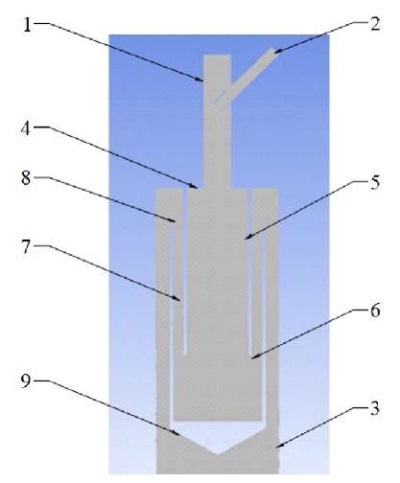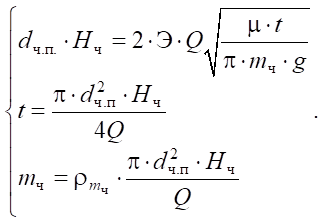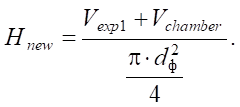Scroll to:
Development of a Calculation Method for a Combined Filter
https://doi.org/10.23947/2541-9129-2025-9-1-7-13
EDN: URXCEZ
Abstract
Introduction. If wastewater treatment becomes less effective, the intensity of treatment facilities should be increased. Several approaches to solving this issue have been described in the literature. For example, to intensify the coagulation process, researchers have used controlled mechanical mixing of coagulants with effluents, mixing with air, and injecting the coagulant using jet or chamber mixers. The authors of this paper propose integrating a vertical clarifying filter (VCF) and a mixing chamber into one housing. This is a novel approach that eliminates the disadvantages of operating separate devices, such as the need for additional space, the possibility of forming aggregates close to the area where they are removed on filters, and avoiding breakage of flakes in connecting pipelines. Experimental evidence has previously demonstrated the effectiveness of this installation. The aim of this study is to develop a scientific methodology for calculating the combined filter, which is essential for widespread adoption.
Materials and Methods. The mixing efficiency of the fluidized bed was determined using the Camp criterion, which characterized the energy spent on mixing. Relevant publications on the subject were also taken into account. Special attention was paid to the description of coagulation. Before developing the calculation method, the authors conducted experiments and created a mathematical model of the installation. The operation of a combined filter with a mixing chamber consisting of a rapid mixing tank with a floating load and a settling tank was considered. The main initial data for the calculation method included: maximum wastewater flow rate, water viscosity, filter diameter, distance from load to housing, backwash intensity, and the volume of expansion of load during backwashing.
Results. The paper shows that the Camp criterion depends on various factors, including mass, area, contact time, and viscosity of particles in a fluidized bed. The calculation of the mixing chamber of the filter was based on this dependence. The regeneration of filters related to the efficiency of backwashing was taken into account. The method for calculating the mixing chamber was presented, and factors that could reduce the effectiveness of backwashing were discussed. As compensation, it was proposed to increase the intensity of backwashing or reduce the height of the filter layer. It was shown how to calculate the dimensions of the mixing chamber elements — the diameter and height of the tanks. A self-check was included in the calculation to avoid errors.
Discussion and Conclusion. For the first time, an improved combined filter design and a method for calculating it are described. The proposed approach makes it possible to determine the dimensions of the mixing chamber and ensure the necessary backwash efficiency. The new solution is of practical interest for enterprises that operate wastewater treatment plants with VCF.
Keywords
For citations:
Ksenofontov B.S., Shirniekh A.A. Development of a Calculation Method for a Combined Filter. Safety of Technogenic and Natural Systems. 2025;9(1):7-13. https://doi.org/10.23947/2541-9129-2025-9-1-7-13. EDN: URXCEZ
Introduction. By the end of 2022, polluted wastewater accounted for an average of 33.4% of the total volume of wastewater in Russia1. One of the main reasons for this issue is insufficient cleaning of wastewater. Industrial facilities use not only one- or two-stage systems, but also integrated solutions that provide several stages of cleaning. They consist of components such as raking devices, reverse osmosis membranes, and evaporation plants. Despite the variety and complexity of these systems, there are several obstacles to their efficiency:
- high cost of equipment;
- outdated structures;
- deterioration of wastewater quality.
To address these challenges, there are several methods that can be used to improve the performance of wastewater treatment plants. These methods include mixing coagulants with water in different ways:
- controlled mechanical [1];
- with the addition of air and concentrated coagulant [2];
- due to cavitation resonance effects [3];
- using jet [4] or chamber mixers [5].
However, these technical solutions have their drawbacks. Firstly, additional space is required to accommodate equipment such as a flocculator or flocculation chamber. Secondly, the areas where aggregates form and are removed from the filters are located some distance apart. Thirdly, when flocculation and filtration are separated, flakes break up in connecting pipelines.
To address this issue, we need water purification systems that integrate multiple processes into one unit. This would improve the existing systems and save space. We would like to emphasize that it concerns upgrading the existing equipment. To achieve this goal, it is advisable to use combined filters.
The aim of the work is to develop a scientifically sound method of calculation that would allow for the replication of positive effects of a combined filter with other filters.
Materials and Methods. The authors propose a utility model of a combined filter [6]. This is a sand filter with a coagulant mixing chamber built into its body. Earlier, the expediency of this approach was proved by the authors of this article [7]. Combined installations and systems are suitable for solving multiple problems simultaneously. For example, biochar can be used to remove microplastics from water [8], and the hybrid membrane distillation system can produce purified water and generate electricity [9], while reverse osmosis can be powered by a concentrated solar gas engine [10].
According to the authors, the proposed utility model of a combined filter (Fig. 1) represents an effective solution for enhancing filtration in existing industries. The design of the presented filter differs slightly from the original one [6], due to design features identified through computer modeling [7]. These features allowed for an increase in the efficiency of the filter.

Fig. 1. Design of the combined filter: 1 — source water pipe; 2 — reagent supply pipe; 3 — filter housing; 4 — mixing chamber; 5 — rapid mixing tank with floating load; 6 — lower overflow; 7 — settling tank; 8 — upper overflow; 9 — cone insert
Through pipes 1 and 2, water and coagulant flow into the rapid mixing tank. The coagulant is mixed in the first chamber under the pressure of source water due to the mixing load. After the coagulant treatment, the water is directed through the lower overflow into the settling tank, and then through the upper overflow into the filter housing.
The coagulant helps to neutralize the charge of colloidal particles [11] and form insoluble compounds [12]. The coagulation process includes two stages [13], for each of which specific zones are provided in the mixing chamber.
The first stage, the perikinetic stage, takes place in the mixing chamber. Due to the special loading inside the chamber, the reagents are evenly and quickly distributed, and a high flow velocity gradient is achieved. Contact coagulation will further increase the efficiency of reagent treatment.
The lower overflow is located between the mixing and flocculation chambers and performs the key function of protecting the mixing load from being carried further into the tank and into the filter. It also helps to reduce flow turbulence.
With a mixing intensity of no more than G = 50 – 60 C⁻¹ [14] optimal conditions for the formation of flakes are created in the chambers.
The second stage of the coagulation process is orthokinetic. It takes place in a settling chamber is accompanied by an increase in the size of colloidal particles greater than1 µm [15]. It implements the functionality of a flocculation chamber.
The source water, together with the formed flakes, enters the filter housing through the upper overflow. A conical insert in the lower part of the housing is needed to eliminate swirls that can destroy the flakes.
When developing the calculation methodology, the authors summarized the literature data, conducted laboratory tests, and performed mathematical modeling. The results of the laboratory studies confirming the effectiveness of the proposed solution are given in [7]. To evaluate the criteria for the processes, the Camp criterion was selected, which evaluated the energy spent on mixing. The literature analysis allowed us to find out how the effectiveness of backwashing depended on its intensity and the degree of load expansion. In addition, the value of the gradient for the fluidized bed was known from publications.
Results
1. Fluidized bed mixing intensity. Fluidized bed mixing intensity was used as a criterion of work efficiency. Based on this indicator, it was possible to use a mixing chamber with filters of various sizes and ensure the previously obtained result [7]. According to [16], the intensity of mixing of the reagent with water was characterized by the Camp criterion:
 (1)
(1)
where t — residence time in the mixing chamber, s; G — velocity gradient, 1/s.
Residence time in the mixing chamber:
 (2)
(2)
where V — volume of the mixing tank, m³; Q — flow rate of source water, m³/s.
Velocity gradient:
 (3)
(3)
where Δp — pressure drop in the mixing chamber, Pa; μ — dynamic viscosity of water, Pa∙s; t — mixing time, s.
According to [17], the pressure drop for a fluidized bed is determined by the formula:
 (4)
(4)
where mч — mass of all particles, kg; g — acceleration of gravity, m/s²; S — cross-sectional area of the mixing tank, m².
Combining (1)–(4), we obtain the equation of the Camp criterion:
 (5)
(5)
Using formula (5) for laboratory bench [7], the Camp criterion was calculated. It was accepted equal to 100 units.
2. Mixing chamber calculating methodology. The following is a method for calculating the mixing chamber and the required initial data for the calculation.
Initial data:
- the Camp criterion, Э;
- maximum flow rate of the treated water, Q, m³/h;
- dynamic viscosity of water, μ, Pa∙s;
- bulk particle density
 kg;
kg; - acceleration of gravity, g, m/s²;
- filter diameter, dф, m;
- height from loading to housing, H, m;
- backwashing intensity, ИОП1, l/(s с∙m²);
- volume of load expansion during backwashing, Vexp1, m³.
By converting formula (5), system of equations (6) can be obtained, which is used to determine the dimensions of the mixing chamber.
 (6)
(6)
Here dч.п. — mixing tank diameter, m; Нч — height of the mixing tank and the settling tank, m.
The flow rate in the settling tank should be equal to the flow rate in the filter housing. To determine the diameter of the settling tank (the entire chamber as a whole), we use the formula:
 (7)
(7)
where dч.у. — settling tank diameter, m.
Let us check whether the chamber fits into the filter housing. To do this, we take into account:
– height of cone insert Нcone (1/4 of the diameter of the chamber);
– margin of the distance from the cone to the load with a minimum height of 1/16 of the diameter of the chamber.
 (8)
(8)
Let us check that the camera size is correct:
 (9)
(9)
If conditions (8) or (9) are not met, then it is necessary to return to (6) and adjust the dimensions of the mixing chamber.
Let us calculate the volume occupied by the mixing chamber:
 (10)
(10)
Let us define the condition for ensuring the necessary load expansion:
 (11)
(11)
If the condition is not met, the backwashing efficiency may be reduced. To address this issue, it is important to understand how backwashing effectiveness can be maintained.
- By increasing the intensity of backwashing, we find new backwashing intensity ИОП2 [18]:
 (12)
(12)
- By reducing the loading height, we find the height value from the housing to the load Hnew, which will provide the necessary volume for the load expansion:
 (13)
(13)
Let us calculate how much the load height needs to be reduced:
 (14)
(14)
3. For calculations related to changes in the intensity and volume of loading, we use formulas (12) and (13), taking into account the necessary conditions. For example, based on the capabilities of specific wastewater treatment plants, we use (13) to set the permissible value for reducing the loading height, set it to (12) and calculate the desired backwashing intensity.
Let us determine the volume of mixing tank Vч.п. and settling tank Vч.у.:
 (15)
(15)
 (16)
(16)
Let us calculate the required volume of mixing load Vload:
 (17)
(17)
Let us calculate water residence time in the mixing and calming tanks:
 (18)
(18)
 (19)
(19)
Discussion and Conclusion. The scientific research results of presented in the paper suggest that it is reasonable to use the proposed method for calculating the filter's performance. Firstly, this method is based on reliable data from published sources. Secondly, its relative simplicity — consisting of only 19 concise formulas — makes it practical for real-world applications. After completing this research, the authors verified the previously obtained findings. It was crucial to demonstrate that the simulated mixing chamber enhances the filtration process and improves coagulation activity. Therefore, we can use the mixing intensity of a fluidized bed as a measure of efficiency. The method of calculating a mixing chamber allows us to determine its size and ensure the required backwash efficiency. This solution can be applied to vertical clarifying filters of various types and sizes. Therefore, this technique can be applied to any production facility that uses such equipment.
1. On the State and Protection of the Environment of the Russian Federation in 2022. The State Report. Ministry of Natural Resources and Ecology of the Russian Federation. (In Russ.) URL: https://2022.ecology-gosdoklad.ru (accessed: 26.08.2024).
References
1. Grigoreva AN, Mekhnetsov IA. Improving the Efficiency of Coagulation Processes by Using Controlled Mechanical Mixing. Nailuchshie Dostupnye Tekhnologii. 2022;(2):36–44. (In Russ.)
2. Safronov MA, Malyutina TV, Horeva IA. Development of a Mixing Unit Design for High-Gradient Mixing of Coagulant Solutions with Water. Engineering Journal of Don. 2021;1:6772. (In Russ.)
3. Курбатов А.Ю. Устройство для смешения коагулянта с водой. Патент РФ № 2021118005. 2021. 6 c. Kurbatov AYu, Kuzin EN, Averina YuM, Vetrova MA, Sitnikov IA. Device for Mixing Coagulant with Water. Patent RF No. RU 207722 U1. 2021. 6 p. (In Russ.)
4. Aleksandrov VA, Kakalov IL, Kursanov NP, Chunosov DV. Static Jet Mixer. Patent RF No. RU 163042 U1. 2008.18 p. (In Russ.)
5. Sobolev KV, Nishukova MA, Rubleva SA. Intensification of Processes of Reagent Wastewater Treatment of the Food Industry Using a New Type Mixer. Advances in Chemistry and Chemical Technology. 2022;36(13):116–117. (In Russ.)
6. Ksenofontov BS. Combined Filter for Water Purification. Patent RF No. RU 209470 U1. 2022. 4 p. (In Russ.) URL: https://patents.s3.yandex.net/RU209470U1_20220316.pdf (accessed: 26.08.2024).
7. Ksenofontov BS, Shirniekh AA. Development of the Mixing Chamber for the Combi-Filter. Industrial Ecology. 2023;4(124):5–11. (In Russ.) https://doi.org/10.52190/2073-2589_2023_4_5
8. Siipola V, Pflugmacher S, Romar H, Wendling L, Koukkari P. Low-Cost Biochar Adsorbents for Water Purification Including Microplastics Removal. Applied Sciences. 2020;10(3):788. https://doi.org/10.3390/app10030788
9. Elminshawy NAS, Gadalla MA, Bassyouni M, El-Nahhas K, Elminshawy A, Elhenawy Y. A Novel Concentrated Photovoltaic-Driven Membrane Distillation Hybrid System for the Simultaneous Production of Electricity and Potable Water. Renewable Energy. 2020;162:802–817. https://doi.org/10.1016/j.renene.2020.08.041
10. Soliman AM, Adil Al-Falahi, Mohamed A Sharaf Eldean, Monaem Elmnifi, Magdi Hassan, Basim Younis, et al. A New System Design of Using Solar Dish-Hydro Combined with reverse osmosis for Sewage Water Treatment: Case Study Al-Marj, Libya. Desalination and Water Treatment. 2020;193:189–211. https://doi.org/10.5004/dwt.2020.25782
11. Dayarathne HNP, Angove MJ, Aryal R, Abuel-Naga H, Mainali B. Removal of Natural Organic Matter from Source Water: Review on Coagulants, Dual Coagulation, Alternative Coagulants, and Mechanisms. Journal of Water Process Engineering. 2021;40:101820. https://doi.org/10.1016/j.jwpe.2020.101820
12. Wei Lun Ang, Abdul Wahab Mohammad. State of the Art and Sustainability of Natural Coagulants in Water and Wastewater Treatment. Journal of Cleaner Production. 2020;262:121267. https://doi.org/10.1016/j.jclepro.2020.121267
13. Jerzy Bałdyga, Grzegorz Tyl, Mounir Bouaifi. Perikinetic and Orthokinetic Aggregation of Small Solid Particles in the Presence of Strong Repulsive Forces. Chemical Engineering Research and Design. 2018;136:491–501. https://doi.org/10.1016/j.cherd.2018.06.021
14. Saritha V, Srinivas N, Srikanth Vuppala NV. Analysis and Optimization of Coagulation and Flocculation Process. Applied Water Science. 2017;7:451–460. http://doi.org/10.1007/s13201-014-0262-y
15. Sinaiskii EG, Lapiga EYa, Zaitsev YuV. Separation of Multiphase Multicomponent Systems. Moscow: Nedra; 2002. 621 p. (In Russ.)
16. Kononchuk OO. Development of Technology for Obtaining Oxychloride Coagulant during Processing of Copper-Ammonia and Aluminum Waste. Author’s thesis. St. Petersburg; 2020. 115 p. (In Russ.)
17. Kochetov OS, Soshenko MV, Bulaev VA. Calculation of an Artificial Microclimate System with a Fluidized Bed Heat Exchanger. In: Proc. of the International Scientific and Practical Conference “Globalization of Science: Problems and Perspectives”. Ufa: Omega Science; 2014. P. 30–33. (In Russ.)
18. Bykov VV. Reverse Flushing Multilayer Filter Media with the Participation of “Sokirnit”, Pyrolox and DMI-65. Vodoochistka. Vodopodgotovka. Vodosnabzhenie. 2017;8(116):12–26. (In Russ.)
About the Authors
B. S. KsenofontovRussian Federation
Boris S. Ksenofontov, Dr. Sci. (Eng.), Professor, Professor of the Department of Ecology and Industrial Safety
bldg. 1, 5, 2nd Baumanskaya St., Basmanny Municipal District, Moscow, 105005
A. A. Shirniekh
Russian Federation
Albert A. Shirniekh, Postgraduate Student of the Department of Ecology and Industrial Safety
bldg. 1, 5, 2nd Baumanskaya St., Basmanny Municipal District, Moscow, 105005
Review
For citations:
Ksenofontov B.S., Shirniekh A.A. Development of a Calculation Method for a Combined Filter. Safety of Technogenic and Natural Systems. 2025;9(1):7-13. https://doi.org/10.23947/2541-9129-2025-9-1-7-13. EDN: URXCEZ








































